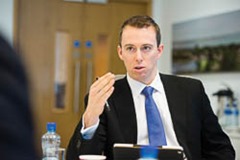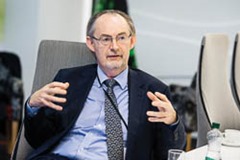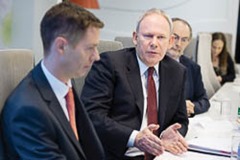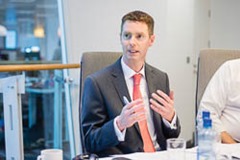Transforming public services through technology
 Vodafone Ireland hosted a round table discussion on how technology can be used to transform public services and what future trends will impact on the delivery of these services.
Vodafone Ireland hosted a round table discussion on how technology can be used to transform public services and what future trends will impact on the delivery of these services.
How can communications technology help citizens engage with government agencies?
Liam Molloy
We’re dealing with a new generation of customers and they want to interact with companies in a non-traditional manner, whether that’s through a mobile app or online. They don’t want to be tied to a nine-to-five customer service centre or wait in a queue for a call centre.
Peter Gallagher
Technology is placing citizens, appropriately, at the very centre. Governments continue to move towards a more customer-centric model evidenced by the DCENR’s National Digital Strategy to get more people and businesses online.
Postal services are viewed universally as being entities that can bind countries together. We’ve done this in the physical world and now we’re extending this into the digital world. Like many posts, we are seen as being a trusted intermediary so we want to leverage that; our 1,143 post offices around the country and a very strong digital infrastructure and use these assets to help the Government’s broader e-strategy.
From a customer point of view, communications technology has changed drastically over the last four to five years. Customers now want to communicate via smartphone or other media devices – whatever suits at that particular point in time. We are seeing a big shift in terms of people wanting to be online and available 24/7 and get information back to them 24/7.
Damian Griffin
The website or mobile application is perhaps the only view a citizen has of a government department or agency. It’s not a matter of going into a physical place anymore. Irish citizens now live in a virtual space. Any IT solution has to be developed with this in mind: to be easy and straightforward to operate for current and future generations. Government departments and agencies, in providing straightforward solutions, create an improved user experience and the potential for improved citizen confidence in government. Irish citizens increasingly require safe access to data and services is a simple and efficient manner.
John Clancy
What we’re seeing from our traditional business is the consumerisation of IT and ICT. The normal person on the street is now a lot more tech-savvy and they have a very sophisticated device in their hand. They want to use the facilities available on that device. As a company, we not only have to supply that device but we have to supply our customers with the technology to enable the services on the device. This is evolving our traditional mobile device and data service into a total communications business.
We are aligning with the eGovernment strategy for 2011-2015 which says that public services should be delivered through the most appropriate channels, to deliver better citizen engagement, and that public bodies should work to ensure that the online channel is the most attractive channel to citizens.
We as a company – globally and in Ireland– are developing our products and marketing ethos around that strategy. Vodafone’s ‘Ready Business’ strategy for government is about empowering organisations around technology to ensure that employees are confidently connected in order to provide quality services to citizens.
The first element of ‘Ready Business’ is better citizen engagement, the second is better operational efficiency and the third is better connected employees. That’s really aligning organisations to what is happening in the marketplace and what citizens need.
Peter Gallagher
Recently, we worked on the Department of the Taoiseach’s Constitutional Convention with our technology partner, Escher, to provide a web portal through which citizens could interact directly with government officials and that has been extremely successful.
Another current initiative (www.licences.ie) is part of the Taoiseach’s drive to make Ireland the best small country in the world to do business. It will allow, initially retailers, to apply for and pay for licences through a single web portal, instead of having to go to multiple different agencies.
Less than 25 per cent of small businesses do business online. That’s unacceptable and David Puttnam, the Digital Champion, has been pushing hard on this. An Post continues to play its part by developing a physical platform and a digital platform called www.growmybusiness.ie which allow small businesses learn tools, techniques and new practices from experienced business practitioners that will help them grow their revenue. Other initiatives such as www.mybills.ie allow citizens to pay over 100 bills – covering local authorities, utilities, An Garda Síochána fixed penalties – at no extra charge, online. It’s just part of the inexorable move towards being more customer-centric.
Our networks business interacts with all householders and ESB also has retail and international businesses. From a CIO perspective, while they are very different businesses, the digital stream is running through all of them.
When we had Storm Darwin back in February and a massive number of outages around the country, our PowerCheck app allowed customers to check when their power would be restored without having to contact our call centre.
On the competitive side, in Electric Ireland, it is a de facto requirement to have a digital strategy. You literally have to be available 24/7. A large constituency of customers want to interact with you online, after-hours and on a self-service basis. In our international business, IT mobility is critical with staff working and living abroad, supported with full access to our enterprise systems.
What are the challenges around having very mobile workforces?
Damian Griffin
The Defence Forces is very positive towards business change and technology. It is a continuous challenge keeping up with new while supporting existing technology, and providing for innovation. Technology can be adapted and tuned over time.
Defence Forces personnel range of age is 18 to 63 and senior management require IT to provide a balance between security and functionality. The Defence Forces lead factor for all solutions is data security. Data is simply becoming more and more important.
We’ve all talked about how citizens can get access to data. Access and storage has to be done securely but not in a way that’s difficult for the user, like having 14 different PIN codes.
The key to technology adoption – you have to engage with your customers. You have to tell them when you’re going to make change and how you’re going to make change. The Defence Forces adopted Microsoft Sharepoint in 2014 – it’s the entire information depositary for the organisation – but we had to change how everyone did their business and all our policies and regulations to make this the centre knowledge point within our organisation.
Brian Duffner
We did a recent study that showed that 86 per cent of multi-national enterprises now consider the implementation of mobile and flexible working as a high to medium priority. In some industries, sitting in the office late at night is no longer seen as dedication. This is changing the way we do business. Mobile devices are becoming more sophisticated and we see the mobile network becoming more and more important.
Peter Gallagher
We found the cost of integrating new and legacy systems to be the greatest cost. Once colleagues make the initial leap into technology, that overcomes much of the fear and anxiety and it then becomes progressively easier to introduce new technology initiatives.
Within An Post, we have 1,400 people working in four main centres around the country who have always been surrounded by technology. We’ve recently invested €25 million in improving their automation capability. All our 4,500 delivery staff now have mobile scanners and can track the delivery of packages and parcels. That technology is very flexible, adaptable and powerful.
Liam Molloy
Staff have an expectation that they can access the same range of IT products in the workplace that they have access to in their home and of course this poses challenges in terms of security. Change and adoption often hasn’t been integrated into the scope and design of projects at an early enough stage. If you don’t incorporate that from the start, you end up with a nice new system but maybe not the adoption level you expected to get from it.
Sometimes companies develop point solutions for mobility. Again, for large enterprise systems, the first step is to implement the right platform to support the fast rollout of apps. We have a project management office where change and adoption is upfront. We’re currently rolling out mobility to our network field workers and we have put the infrastructure in place including an ESB apps store.
We know that the growth in productivity apps will continue to increase. If you get your infrastructure right, then the apps are not a major issue after that. Our big ticket objective is unified communications where we run all of our voice and data communications through our IP network providing staff with fully integrated access to a range of collaboration products such as tele- conference facilities, their calendars, instant messaging, their phone etc – colleagues will know if someone is available or not and their telephone number moves with them as they hot desk around the business.
John Clancy
Employees expect more flexibility. Seventy-five per cent of employees cite flexible working as a top-line benefit these days. The first challenge in the public sector is around resources and organisations need the resources to enable the workforce to work in a flexible manner. The second one is data integrity and security.
We are working with a lot of agencies first of all to provide security around connectivity and the communications channel and then encryption of data when it’s on these devices. The market is moving towards the cloud and we see enabling our customers to connect to public and private cloud as the way to drive the mobility story – rather than trying to create point in time products and services which are inflexible and difficult to keep current and relevant.
We have won a seven-year contract to build a high-speed data backbone for the Irish Government. That will allow any government agency to connect to high-speed broadband and access any public or private data centre available in the Irish market. This network will deliver ICT as a service for any agency and allows them to move workloads in a safe and secure manner into the cloud. We have also invested heavily in 4G as well to allow mobility and fixed devices to connect to that technology.
Liam Molloy
If you’re running a large customer-facing business, availability is your absolute number one priority and enterprise cloud providers need to demonstrate that they can deliver that assurance because there have been issues with the cloud. It is clearly the way to go in terms of collaboration.
For most of the customers we work with, mobility is a big area. Teagasc has a farmers’ application where people can upload information about fertilisers online and access the Teagasc website for information. We delivered a SaaS model for this as the in-life management of the service was unmanageable in a traditional premises model.
With St James’s Hospital, we have removed a paper-based process. Anyone prescribing medicine would traditionally have used a paper-based form which was published once every two years. Now that’s all electronic and they can create new drop-down menus and publish them back out to users.
Damian Griffin
Cloud adoption is about security, risk acceptance and service level agreements. Knowing the timeline and data exposure when it goes down and your phone is ringing.
John Clancy
The Office of the Government Chief Information Officer have indicated that they will move towards building their own private clouds – on the high speed backbone that we’ve built for them – but it will not be a catch-all and we see a hybrid model of public and private cloud services delivering ICT for the public sector in the future based on requirements and security and confidentiality levels of the data.
Damian Griffin
Based on the nature of the data, it will always be between the two; public and private. There will always be data that will never go outside the organisation.
Liam Molloy
Another aspect is that there are a lot of disparate systems. You will always have a citizen who will want to make that phone call so you’re going to have a call centre agent at the end of the line and there is an issue about legacy systems and how much information is made available to the call centre agent to provide citizens with a comprehensive service.
Looking at how you engage citizens online, where are agencies in the lifecycle of engaging with citizens other than the traditional audio or face to face channels?
Brian Duffner
Looking at where we have been and where we are going to, I saw a statistic recently that showed that in the next three to five years every website will have communications built into it, with the ability to have a live communication with an agent. Video is becoming very prominent and will feature more and more on websites. The idea of having a static web page over the next three years will become redundant.
John Clancy
We are now moving into an era of omni-channel – anyone who is running a contact centre needs to move into omni-channel. You can no longer just interface with your customers on audio or through face-to-face engagement. You now need to have email, web chat and video. We are seeing companies who use omni-channel linking social media into their customer care agents. The agent can then respond to social media posts and change a negative experience to a positive one. We are seeing some of the larger government agencies who are customer facing moving to omni-channel.
Many people only associate An Post with our retail offices and the 4,500 postmen delivering their mail. We are a very technologically advanced company with a digital infrastructure that complements the physical aspects of our business.
We are active users of social media, we monitor mentions of An Post and topics of interest to An Post in real time. Having an omni-channel call centre allows us to respond quickly to mentions of any issues.
What are the future trends you see making a difference to your agency’s ICT and communications strategy?
John Clancy
One of our four key pillars is cloud and hosting over the coming 10 years because that’s where we see the market going. One of the other pillars is connectedness and the internet of things. Vodafone has taken its traditional macro mobile network and created a new, completely separate network platform dedicated to machine to machine services.
We have a trial running in Dublin City where SIMs are attached to bicycles which are collecting temperature and air pollution data. This information is going back into a huge database, monitored by a data analytics tool.
Also, all car and truck manufacturers are now deploying SIMs as part of the on-board computers. These then interface with the customer service model to secure the vehicles and notify when the vehicle needs to be serviced.
There’s a huge emergence of start-up companies particularly in Ireland. We have a requirement for a testing and development environment where these companies can take some space in a pseudo-mobile network and develop their product.
In machine-to-machine technology, our global data SIM platform forms a huge part of our global strategy for the coming years and very soon the SIMs will disappear and become an embedded part of the device with the ability to roam on all networks. The world already has more mobile connected devices than people and that will explode again over the next five years.
Liam Molloy
To date, the electricity industry has been very centralised. If you look at distributed technologies like solar panels, combined heat and power generation units in the home or an electric vehicle parked outside your house, the customer of the future will potentially not just be consuming the product but may also be selling power back into the grid.
The summer demand in Germany last year was completely met by solar panels on roofs which meant that the larger generation units were stood down. Now, you have power flowing in different directions and the smart grid of the future will manage those flows and also incorporate technology whereby issues on the grid are resolved by intelligent systems.
Customers in their homes will, we expect, be looking for domestic management systems: a worktop console to manage their alarm, heating system, appliances etc., interacting with their smart meter and electricity supplier.
Wrapped round all that we’re talking about a business where we’re reading a customer’s meter remotely every 15 minutes: 365 days a year. You’re into big data, the technology to handle that big data and the analytical tools to provide customers with a range of new services.
ESB has recently formed a JV with Vodafone to roll out a high speed fibre backbone to towns all over the country. There may be a lot of other potential collaborations out there in the Public Service.
John Clancy
The public sector doesn’t necessarily have the resources to do all that it needs to do so it has to collaborate with the private sector, which is a good thing for both sectors.
Peter Gallagher
New technologies will always disrupt An Post’s existing practices and networks. Decline in our core mail volume has been driven largely by the internet and SMS but this does give rise to new opportunities, obviously in parcels. Digital mail as a standalone proposition hasn’t proved to be a compelling business case but what we do want to do is see how our digital competence can be integrated into our growth strategy.
We’ve obviously looking at big data. The Universal Postal Union has developed a number of projects which show that posts can become more agile on the back of big data. We’re also paying very close attention to the Government’s desire for Ireland to become a more cashless and financially inclusive society so we have a number of initiatives ongoing in this area. We, like the Government, have to do more with less so we will be looking at partnerships that make commercial sense.
It’s all about the immediacy of the information. In the military, we’ve had a private internet of things for generations. The soldier at the front with the radio had to get the message back to the commander and it was always based on: “How does he get it back? Do you have throughput? And do you have security?”
Email is nearly reaching congestion point in many organisations. It’s going to be interesting how innovation around email can make it more task-orientated so it actually becomes useful for an organisation instead of a repository of personal workflows.
The future is about user self-service while we still maintain governance. It will be disruptive but will allow us to do more with less. It will allow us to license and provision easier and understand their needs and wants. The challenge is the control of our IT service catalogue, retiring old services and bringing on the new ones which are going to match the generations of customer, trying to always have a rolling IT strategy and to guess a little about how we’re getting where we need to go to.
Peter Gallagher
Evolving into a more digital business forms a key part of our business strategy. One thing you will see is the increase in peer-to-peer messaging and how that allows for more secure, efficient and effective communication. We already use that technology throughout our retail network. We’ve been working with an Irish technology company and see real possibilities. We have more apps on our retail platform than any other post globally.
Brian Duffner
The internet of things is probably the most fascinating trend. The number of devices that connect to the internet today is due to grow fivefold in the next five years. We are seeing things like contact lenses now having little chips in them to read diabetes indicators and feed those back centrally.
The more immediate trend is a convergence of ICT, communications and cloud: almost taking your office home away with you. It’s about being able to stand on the side of a road, pick up a document on a tablet, share it with someone in the office to make last minute changes securely and basically progress a piece of work on the move. The bandwidth available has played a big role in how people are shifting work trends.
The Participants
John Clancy
An engineer by background, John Clancy has been with Vodafone for five years, initially supplying complex solutions to customers moving from mobility to total communication. He also helped to develop Vodafone’s enterprise partner ecosystem and led the technical sales team. He has recently taken up a new role as Head of Public Sector Business in Vodafone Ireland.
Brian Duffner
Brian Duffner is responsible for the Vodafone Ireland Converged Communications portfolio and has been with Vodafone for four years. With a background in IT and computer programming, Brian has in recent years worked in different pre-sales and product roles in various Irish operators.
Peter Gallagher
Peter Gallagher is Director of Strategy and Business Excellence with An Post. He is responsible for corporate strategy and business performance improvement. Previously, he was a Partner in PA Consulting’s Global Business Transformation Practice, Director of Strategy with KPMG Consulting, and Business Operations Manager (UK and Ireland) for Dell.
Damian Griffin
Damian Griffin is the CTO and Network Co-Ordinator for the Defence Forces. Holding the rank of commandant he has continually delivered secure and innovative IT solutions for DF personnel in Ireland and overseas. He is currently investigating the secure network implementation of virtual desktop. Damian is a chartered engineer and CISSP (certified information systems security professional).
Liam Molloy
Liam Molloy is CIO at ESB. Previously, he held roles as General Manager of Electric Ireland and Managing Director of ESB Independent Energy Ltd. He has 40 years’ experience in the electricity industry in Ireland and internationally. Liam is a member of the ICC Digital Economy Commission and the ICS CIO Forum, and has served on a number of ESBI company boards.










